Copyright © Michigan Foot and Ankle | Site Map | Nondiscrimination Policy | Design by: Podiatry Content Connection
Medical Miracles
Medical Miracles
Drs. Lefkowitz, Stock and Ward are committed to making sure our patients receive the best care available. By attending over 50 hours of continuing education each year, the doctors keep abreast of the latest techniques and innovative procedures for medical and surgical treatment of the foot and ankle.
A Sample of Our Doctors Diligence!!
NEW!! Certified in OssaTron "Extracorporeal Shock Wave" for the treatment of chronic heel pain and plantar fasciitis.
Among the first in Michigan to implement "Apligraf" for treatment of diabetic foot and venous leg ulcers.
Among the first in Michigan to use "Interpore Coralline Hydroxyapatite" for bone surgery and have been doing so since 1996. Since then, Dr. Lefkowitz has lectured on this topic across the globe!
First in Michigan to provide Autologous Platelet Concentrate (APC) injection in an office for plantar fasciitis and sports injuries.
New innovative treatment for patients suffering with diabetic foot or venous leg ulcers!!
There are 2 main causes of diabetic foot ulcers. Most often, they result from lack of feeling in the feet (neuropathy). This condition can result in injury because normally painful sensations, such as stepping on a pin, cannot be felt and therefore may not be properly treated. Continuing to walk on the injured foot may cause an ulcer to develop.
Poor circulation in your legs and feet can also cause the skin to break down, forming an ulcer.
The standard treatment for healing diabetic foot ulcers is typically a combination of surgically removing dead skin, bandaging the wound, and staying off the injured foot. However, this may take a long time and doesn't always work.
Today, an innovative treatment called Apligraf may be a better answer. Apligraf is actual living skin that is bioengineered, grown in the laboratory from cells of neonatal (infant) foreskin. It is delivered for the doctor's use in a Petri dish ready for ulcer application. When combined with standard treatment, Apligraf has been shown to heal more diabetic foot ulcers faster than standard treatment alone. In fact, Apligraf can help heal foot ulcers that have been present for 3 weeks or longer, 2 to 3 times as fast. Ask our doctors if Apligraf can work for you.
Our doctors have been using Apligraf since 1999 and were among the first in Michigan to use this innovative technology. Since then, Dr. Lefkowtiz has lectured and taught hundreds of doctors how to use Apligraf properly.


What is it? In layman's translation, it's "the filling of bone cysts with sea coral" for the treatment of bone cysts and bone grafting.
Sounds like science fiction? Well, this actually makes perfect scientific sense. Viewed under an electron microscope, sea coral and human bone tissue are nearly identical. When scientists discovered this, the next step was using the ocean matter to repair damaged bones.
The process works like this: when a patient suffers from a bone cyst, the bone becomes as fragile as an eggshell. In a single operation, the cyst is drained and sea coral is used to fill the cyst and fortify the bone. The porous coral acts as a latticework, over which existing bone can crawl and grow across the gap. The end result is solid, natural bone matter. There is one limitation. Since the coral itself is not solid, it cannot be used for weight-bearing bones. Cystic long leg bones, for instance, are ineligible for the process. For spongy bones (knees, heels, ankles, etc.), sea coral is ideal and one that might revolutionize bone surgery.
Ask our doctors if Interpore Coralline Hydroxyapatite can work for you.
Our doctors were among the first in the state to use Interpore for bone surgery and have been doing so since 1996. Since then, Dr. Lefkowitz has lectured on this topic across the globe!
Traditional treatments for heel pain consist of anti-inflammatory medications, injections, padding, orthotic inserts and even surgical release of the plantar fascia ligament or heel spur removal. For resistant heel pain our doctors now perform the latest non-incisional surgery for heel pain and plantar fasciitis. "Extracorporeal Shock Wave Treatment" "Extracorporeal" means "outside the body". Shock waves are created by very strong acoustic (sound) energy. Your ESW treatment will be performed with a device called the OssaTron. The shock waves are created by a spark plug that is enclosed in a soft plastic dome filled with water. During ESW treatment, this dome is placed close against the heel so that the shock waves pass through the dome to the heel. ESW treatment has recently been found to be effective for treating chronic proximal plantar fasciitis, a condition that causes pain in the heel of the affected foot and is sometimes call "heel spurs".
Our doctors are certified in OssaTron "Extracorporeal Shock Wave" by Healthtronics the only manufactures of the OssaTron in the country. WOW!!
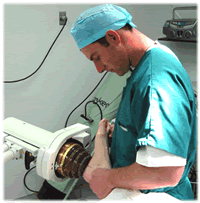
Do you have a nail infection?
- Are any of your nails discolored - white, yellow or brown?
- Are any of your nails thick, brittle or flaky?
- Do you experience pain in and around your nails?
- Have you noticed the problem getting worse?
- If you answer "yes" to any of these questions, visit our office right away.
ASK OUR DOCTORS HOW LAMISIL CAN HELP YOU.
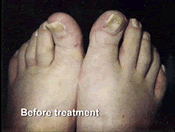
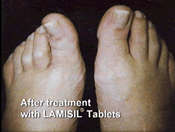

Venous leg ulcers result from poor circulation of blood from your legs to your heart. The increased pressure of blood backing up in your leg may cause the skin to break down, forming an ulcer.
The standard treatment for venous leg ulcers has traditionally been compression therapy. Compression therapy consists of a tightly wrapped bandage that produces pressure around the ulcer and helps push blood away from the ulcer site and back up to the heart. Although it can be an effective treatment, compression therapy may take a long time to heal the ulcer and does not work for everyone.
Today, an innovative treatment called Apligraf may be a better answer. Apligraf is actual living skin that is bioengineered, grown in the laboratory from cells of neonatal (infant) foreskin. It is delivered for the doctor's use in a Petri dish ready for ulcer application. When combined with standard treatment, Apligraf has been shown to heal more diabetic foot ulcers faster than standard treatment alone. In fact, Apligraf can help heal foot ulcers that have been present for 3 weeks or longer, 2 � to 3 times as fast. Ask our doctors if Apligraf can work for you.
Our doctors have been using Apligraf since 1999 and were among the first in Michigan to use this innovative technology. Since then, Dr. Lefkowtiz has lectured and taught hundreds of doctors how to use Apligraf properly.
DIABETIC FOOT FACTS
Provided By:
MICHIGAN FOOT AND ANKLE
Harvey Lefkowitz, D.P.M.
Michelle Jupin, D.P.M.
Anthony Mastrogiacomo, D.P.M.
Did you know that if you are a diabetic you are at a higher risk of developing serious foot conditions in your lifetime?
Some of the most common conditions that effect diabetic patients are:
- Neuropathy (Nerve Damage)
Your ability to detect sensations or vibration may be diminished. Neuropathy allows injuries to remain unnoticed and untreated for lengthy periods of time. - Poor Circulation
Persons with diabetes often have circulation disorders (peripheral vascular disease) - Infection
Persons with diabetes are generally more prone to infections than non-diabetic people. - Foot Deformities
Foot deformities such as hammertoes, bunions, and metatarsal disorders have special significance in the diabetic population. Neuropathy places the foot at increased risk for developing corns, calluses, blisters and ulcerations. If left untreated, serious infections may result.
It is very important that diabetics inspect their feet daily for blisters, bleeding, and sores between your toes. Use a mirror to inspect the bottoms of your feet, and always make sure to wear proper fitting shoe gear.
As a diabetic you may qualify for "extra depth" shoes. These are custom molded or extra depth shoes that adapt to your particular needs, or orthoses to provide cushioning and support.
As a benefit under Medicare, many diabetics qualify for these shoes and insoles.
According to the Feet Can Last a Lifetime - a publication of the National Diabetes Education Program
- The total annual cost for the more than 86,000 amputations is over $1.1 billion dollars. This cost does not include surgeons' fees, rehabilitation costs, prosthesis; time lost from work, and disability payments. Foot disease is the most common complication of diabetes leading to hospitalization. In 1995, foot disease accounted for 6 percent of hospital discharges listing diabetes and lower extremity ulcers.
- 15 percent of people with diabetes will experience a foot ulcer and between 14 and 24 percent of those with a foot ulcer will require an amputation
- After an amputation, the chance of another amputation of the same extremity or of the opposite extremity within 5 years is as high as 50 percent. The 5-year mortality rate after lower extremity amputation ranges from 39 to 68 percent. According to the National Institute of Diabetes and Digestive and Kidney Diseases (NIDDK) (60-70 percent of patients with diabetes have some form of neuropathy.)
Call one of our offices today for a diabetic foot exam and a consultation with one of our physicians. Find out if you qualify for the Medicare Diabetic Shoe Program.
Most of us know about ultrasound from viewing a pregnant woman's belly. While the machine used by our doctors is the same the probe that touches the foot and ankle has been modified for musculoskeletal evaluation.
Our doctors are now able to painlessly view bones, tendons, ligaments and related structure all in real time imaging. In other words with diagnostic ultrasound we can watch the bones tendons and ligaments as they move finding problems that often hurt you and are only visible while they are in motion. This is a revolutionary change from how we examined our patients just a few years ago. It is a tool that has allowed us to do an even better job then before. We are among the first in our region to utilize this advanced technology in our practice.
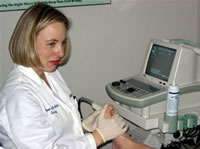
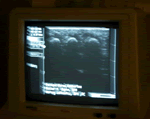
HELPING YOURSELF HEAL
Understanding how your body's natural growth factors may help accelerate the healing process Dr. Lefkowitz - First in Michigan to use APC in office setting
Individuals undergo surgery for a variety of different reasons. For some, the decision is prompted by the need to repair damage caused by trauma, birth defects, and/or the aging process. For others, the decision is to improve their personal appearance and well-being. In either situation, Autologus Platelet Concentrate enriched with growth factors (APC+) is one tool used by surgeons to help improve surgical outcomes. APC+ is made from a small sample of your own blood (approximately 1 1/2 oz.). The process concentrates the platelets found in the blood sample. These concentrated platelets contain huge reservoirs of growth and wound healing factors. Growth and healing factors are natural components of your body. Clinical data has shown that growth and wound healing factors may enhance and accelerate your body's normal healing process. The use of APC+ is now readily accessible in our office. Potential benefits of APC+ include the reduction of bleeding and bruising, decreased inflammation and swelling, enhanced closure, accelerated bone growth, and reduction of overall healing times.
HOW LONG HAS APC+ BEEN USED?
APC+ has been used clinically for over a decade. Leading clinicians in specialties such as dental, ENT, Facial Plastic & Reconstructive Surgery. Orthopedics, Cardiovascular, Plastic Surgery and Wound Healing routinely use APC + to deliver a cocktail of natural, bioactive growth factors.
HOW COULD APC+ BE USED FOR ME
The use of APC+ varies from procedure to procedure. Common podiatric use of APC+ are, plantar fascitis, non-union or delay union of bone, post-op or intra operative foot and ankle surgery tendon injuries.
WHY IS APC+ (ENRICHED WITH GROWTH FACTORS) PREFERRED OVER OTHER PRODUCTS OR METHODS?
APC+ is the only available product that contains elevated levels of all your naturally occurring growth factors. These growth factors are maintained in precisely the same ratios found circulating in your body. Although recombinant products are available, these products are usually synthetic derivatives of a single growth factor. Fibrin glues are another product readily available to the physician. However, the fibrin glues currently marketed do not contain any growth factors and are virally inactivated derivatives of blood components drawn from other donors.
IS APC+ SAFE?
APC+ is derived from a small quantity of your own blood. The APC+ is made point-of-care under physician's control. Also, since the APC+ is made from your own blood, it is insulated against the risk of disease transmission.
WHO MAKES APC+?
Historically, the production of APC+ at the time of surgery was complex, time consuming, expensive, and required large blood volumes. The process often involved outside personnel and a transfusion of blood products. The recent introduction of small automated, office based APC+ systems makes the benefits of APC+ practical in the office and outpatient setting. Now, our doctors and staff prepare APC+ in parallel with the surgical procedure.
HOW IS APC+ MADE?
20cc of your blood is placed in a specialized centrifuge that spins and automatically separates the red blood cells from the plasma. The plasma is then further centrifuged to concentrate the autologous platelets and hence your natural growth factors. The APC+ is then available for our doctors use as needed. The entire process takes less then 15 minutes.
WHAT IS AUTOLOGOUS PLATELET CONCENTRATE (APC)?
Autologous Platelet Concentrate (APC) is composed of platelets and plasma. Platelets are tiny cells that are partially responsible for causing blood to clot. Platelets also contain large reservoirs of natural growth factors. While a normal concentration of platelet circulating in your blood is 200,000 per micro liter, the platelet count in PRP can exceed 2 million platelets per micro liter.
WHAT ARE GROWTH FACTORS?
Platelets contain potent growth factors necessary to begin tissue repair and regeneration at the wound site. Growth factors derived from platelets initiate connective tissue healing, bone regeneration and repair, promote development of new blood vessels, and stimulate the wound healing process.
IS AUTOLOGOUS PLATELET CONCENTRATE ENRICHED WITH GROWTH FACTORS (APC+) FOR YOU?
The use of APC+ is considered by many to be a "new frontier" of clinical therapy. Since APC+ can be used in so many types of procedures and for so many types of patients, you should discuss your specific surgery with your doctor.
Links
Dr. Harvey Leflcowitz, D.P.M., D.A.B.P.S.
Formatted by Brandi Keyosky
Clinical History:
50-year-old female with right ankle pain for approximately two months. Patient may have injured her foot from walking over a long period of time during the month of December, 2007. Patient did not report any overt injury other than the increased walking in the mall during the holiday season of December.
Patient Symptoms & Signs:
Pain over the anterior lateral ankle mortise and talar neck area
No instability on range of motion, palpable click on supination and pronation
Marked pes planus and history of synovitis and difficulty with healing
MM Diagnosis - 2/28/08 (Figure 1):
Incomplete stress fracture of talus specifically at the talar neck. Review of scans reveals obvious lack of blood flow to the head of the talus while the body is well perfused on T2 weighted images. Concern for osteonecrosis of the talar head concerning the fracture line going through the nutrient artery of the talar neck. Posterior tibial tenosynovitis secondary to talar neck injury.
Thought and Rationale:
Due to patient's previous history of difficulty with healing from prior surgical procedures in the foot and anide, as well as the wrist and various other areas of her musculoskeletal system, recoimnendations and decision for use of PRP along with external bone stimulator and immobilization was recommended and followed through.
Description of Procedure - 3/11/08:
Patient presented with chronic delayed union of the right talus, which had been present now for approximately three months. A total ankle block was performed, and under ultrasound guidance 3.3 cc of hemocyte tissue matrix was implanted into the sinus tarsi laterally to the talar neck and dorsally to the talar neck. Patient was instructed to refrain from taking all of her NSAIDS and only to use Tylenol. She was placed into a below-knee AirWalker, and an external bone stimulator from FBI was ordered.
Patient Follow-up:
3/18/08 - The patient received her EBI bone stimulator and was trained appropriately.
4/1/08 - The patient continued to have a stabbing type pain and having used the FBI bone stimulator for 11 hours/day x 13 days with 0 unused days.
4/8/08 - We prescribed a Roll-A-Bout for the patient to remain essentially nonweightbearing, as our concern with healing continued. In addition, she was put on had used her external bone stimulator 40 days with 11.4 hours/day and continued to guard the area with the Cam Walker and the EBI unit. Our thought process was that she might require another APC should the talar neck fracture not heal. Our main concern was the fact that the fracture was traversing the nutrient artery in the talar neck. We previously recommended the patient go for bone density testing, which had been performed by her primary care doctor with the results indicating osteopenia with increased risk for fracture.
Repeat Mill - 5/20/08 (Figure 2):
Revealed marked improvement and healing of the edema and stress fracture of the talus since previous examination. 12 weighted images are consistent for the body, neck and head of the talus, being well perfused. Patient continued to use her external bone stimulator with 61 days x 11.22 hours/day used. She remains in an AirWalker for several more weeks, and we anticipate complete recovery (see copies of before and after MRIs).
Patient Follow-up - 6/1 7/08:
She is returned to shoes and has minimal pain. APC enabled neovascularization into the head of the talus.
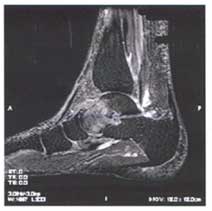
Fig. 1(2/28/08)
Incomplete stress fracture of the talus with lack of blood flow to the head of talus
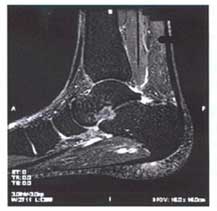
Fig. 2 (5/20/08)
Well perfused, healing talus
Conclusion:
Autologous platelet concentrate injections can be an effective minimally invasive treatment on stress fractures and enables neovascularization into bones. The Harvest SmartPRep process for concentrating autologous platelet rich plasma is a fairly simple outpatient procedure.
Dr. Harvey Leflcowitz, D.P.M., D.A.B.P.S. Formatted by Brandi Keyosky
Clinical History:
43-year-old, healthy, black female presented complaining of painful bunions with excessively long proximal phalanx to the great toe. Previous surgery by another physician had included arthroplasty on the second and third toe with lateral deviation.
X-ray Diagnosis:
2/9/08 - (Figure 1) X-ray shows bunion deformity with excessively long proximal phalanx of the hallux.
Surgical Intervention:
3/28/07 - (Figure 2) Patient underwent hammertoe implants of two and three digits right foot along with cylindrical Akin osteotomy with K-wire fixation.
5/17/07 - (Figure 3) Review of recurrent x-ray reveals osteotomy and proximal phalanx still open and visible with delayed healing. K-wire is still intact.
Description of Procedure - 5/21/07:
APC utilizing SmartPfteP System was performed. 3.5 cc of a huffy coat hemocytic tissue was procured and a hallux block was given to the affected hallux utilizing 3 cc of 1% Lidocaine. The plasma kit coagulate was then infused into the proximal phalanx of the delayed union under ultrasound guidance in order to apply the autologous platelet concentrate directly into the osteotomy and periosteotomy areas.
Patient Follow-up X-rays:
5/31/07 - One of the K-wires had been pulled on.
6/7/07 (Figure 4) Reveals bony bridging across the osteotomy site, and one of the K-wires was removed.
7/6/07 - (Figure 5) Follow-up x-ray, both K-wires removed with complete bony union without complication. Patient was kept in a surgical shoe during the post-APC healing.
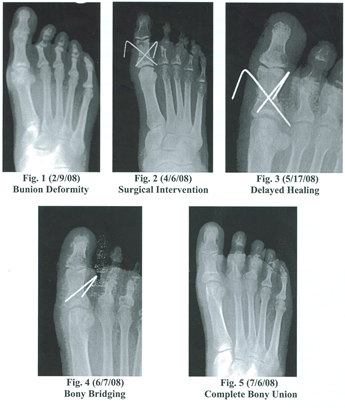
Conclusion:
APC releases growth factors that are necessary for bone healing. APC injection with ultrasound guidance should be considered as a treatment option in patients with delayed bone healing The Harvest SmartPReP process for concentrating autologous platelet rich plasma is a fairly simple outpatient procedure.






